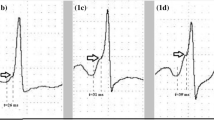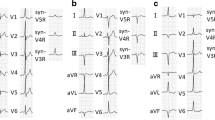Abstract
Purpose
The aim of this study was to investigate the accuracy of three algorithms in predicting accessory pathway locations in adult patients with Wolff-Parkinson-White syndrome in Turkish population.
Methods
A total of 207 adult patients with Wolff-Parkinson-White syndrome were retrospectively analyzed. The most preexcited 12-lead electrocardiogram in sinus rhythm was used for analysis. Two investigators blinded to the patient data used three algorithms for prediction of accessory pathway location.
Results
Among all locations, 48.5 % were left-sided, 44 % were right-sided, and 7.5 % were located in the midseptum or anteroseptum. When only exact locations were accepted as match, predictive accuracy for Chiang was 71.5 %, 72.4 % for d’Avila, and 71.5 % for Arruda. The percentage of predictive accuracy of all algorithms did not differ between the algorithms (p = 1.000; p = 0.875; p = 0.885, respectively). The best algorithm for prediction of right-sided, left-sided, and anteroseptal and midseptal accessory pathways was Arruda (p < 0.001). Arruda was significantly better than d’Avila in predicting adjacent sites (p = 0.035) and the percent of the contralateral site prediction was higher with d’Avila than Arruda (p = 0.013).
Conclusions
All algorithms were similar in predicting accessory pathway location and the predicted accuracy was lower than previously reported by their authors. However, according to the accessory pathway site, the algorithm designed by Arruda et al. showed better predictions than the other algorithms and using this algorithm may provide advantages before a planned ablation.





Similar content being viewed by others
References
Gallagher, J. J., Smith, W. M., Kasell, J. H., Benson, D. W., Jr., Sterba, R., & Grant, A. O. (1981). Role of Mahaim fibers in cardiac arrhythmias in man. Circulation, 64(1), 176–189.
Chiang, C. E., Chen, S. A., Teo, W. S., Tsai, D. S., Wu, T. J., Cheng, C. C., et al. (1995). An accurate stepwise electrocardiographic algorithm for localization of accessory pathways in patients with Wolff-Parkinson-White syndrome from a comprehensive analysis of delta waves and R/S ratio during sinus rhythm. American Journal of Cardiology, 76(1), 40–46.
Arruda, M. S., McClelland, J. H., Wang, X., Beckman, K. J., Widman, L. E., Gonzalez, M. D., et al. (1998). Development and validation of an ECG algorithm for identifying accessory pathway ablation site in Wolff-Parkinson-White syndrome. Journal of Cardiovascular Electrophysiology, 9(1), 2–12.
d’Avila, A., Brugada, J., Skeberis, V., Andries, E., Sosa, E., & Brugada, P. (1995). A fast and reliable algorithm to localize accessory pathways based on the polarity of the QRS complex on the surface ECG during sinus rhythm. Pacing and Clinical Electrophysiology, 18(9Pt 1), 1615–1627.
Boersma, L., García-Moran, E., Mont, L., & Brugada, J. (2002). Accessory pathway localization by QRS polarity in children with Wolff-Parkinson-White syndrome. Journal of Cardiovascular Electrophysiology, 13(12), 1222–1226.
Fitzpatrick, A. P., Gonzales, R. P., Lesh, M. D., Modin, G. W., Lee, R. J., & Scheinman, M. M. (1994). New algorithm for the localization of accessory atrioventricular connections using a baseline electrocardiogram. American College of Cardiology, 23(5), 107–116.
Iturralde, P., Araya-Gomez, V., Colin, L., Kershenovich, S., de Micheli, A., & Gonzalez-Hermosillo, J. A. (1996). A new ECG algorithm for the localization of accessory pathways using only the polarity of the QRS complex. Journal of Electrocardiology, 29(4), 289–299.
Xie, B., Heald, S. C., Bashir, Y., Katritsis, D., Murgatroyd, F. D., Camm, A. J., et al. (1994). Localization of accessory pathways from the 12-lead electrocardiogram using a new algorithm. American Journal of Cardiology, 74(2), 161–165.
Wren, C., Vogel, M., Lord, S., Abrams, D., Bourke, J., Rees, P., et al. (2012). Accuracy of algorithms to predict accessory pathway location in children with Wolff-Parkinson-White syndrome. Heart, 98(3), 202–206.
Bar-Cohen, Y., Khairy, P., Morwood, J., Alexander, M. E., Cecchin, F., & Berul, C. I. (2006). Inaccuracy of Wolff-Parkinson-white accessory pathway localization algorithms in children and patients with congenital heart defects. Journal of Cardiovascular Electrophysiology, 17(7), 712–716.
Basiouny, T., de Chillou, C., Fareh, S., Kirkorian, G., Messier, M., Sadoul, N., et al. (1999). Accuracy and limitations of published algorithms using the twelve-lead electrocardiogram to localize overt atrioventricular accessory pathways. Journal of Cardiovascular Electrophysiology, 10(10), 1340–1349.
Cosío, F. G., Anderson, R. H., Becker, A., Borggrefe, M., Campbell, R. W., Gaita, F., et al. (1999). Living anatomy of the atrioventricular junctions. A guide to electrophysiological mapping. A Consensus Statement from the Cardiac Nomenclature Study Group, Working Group of Arrhythmias, European Society of Cardiology, and the Task Force on Cardiac Nomenclature from NASPE. North American Society of Pacing and Electrophysiology. European Heart Journal, 20(15), 1068–1075.
Alvarez López, M., García Alberola, A., Tercedor, L., Arenal, A., Pérez Villacastín, J., Almendral, J., et al. (1996). Comparative study of 3 algorithms to localize the accessory pathway in Wolff-Parkinson-White syndrome. Revista Española de Cardiología, 49(8), 589–597.
Frank, R., Chandon, E., Deschamps, J. P., Leclerc, J. F., & Fontaine, G. (1990). Revision of criteria for locating the accessory pathway by electrocardiogram in Wolff-Parkinson-White syndrome. A new algorithm. Annales de Cardiologie et d’Angéiologie, 39(4), 225–231.
Acknowledgements
None.
Compliance with ethical standards
ᅟ
Ethics approval
The study protocol was approved by the local institutional ethics committee.
Conflict of interest
The authors declare that they have no competing interests.
Author information
Authors and Affiliations
Corresponding author
Rights and permissions
About this article
Cite this article
Maden, O., Balci, K.G., Selcuk, M.T. et al. Comparison of the accuracy of three algorithms in predicting accessory pathways among adult Wolff-Parkinson-White syndrome patients. J Interv Card Electrophysiol 44, 213–219 (2015). https://doi.org/10.1007/s10840-015-0057-6
Received:
Accepted:
Published:
Issue Date:
DOI: https://doi.org/10.1007/s10840-015-0057-6




